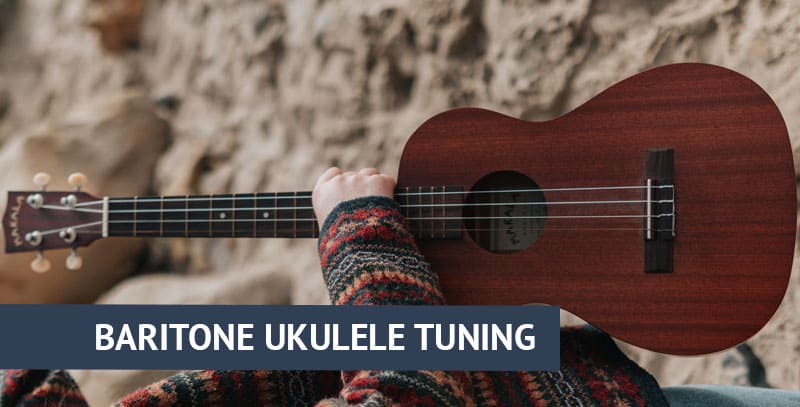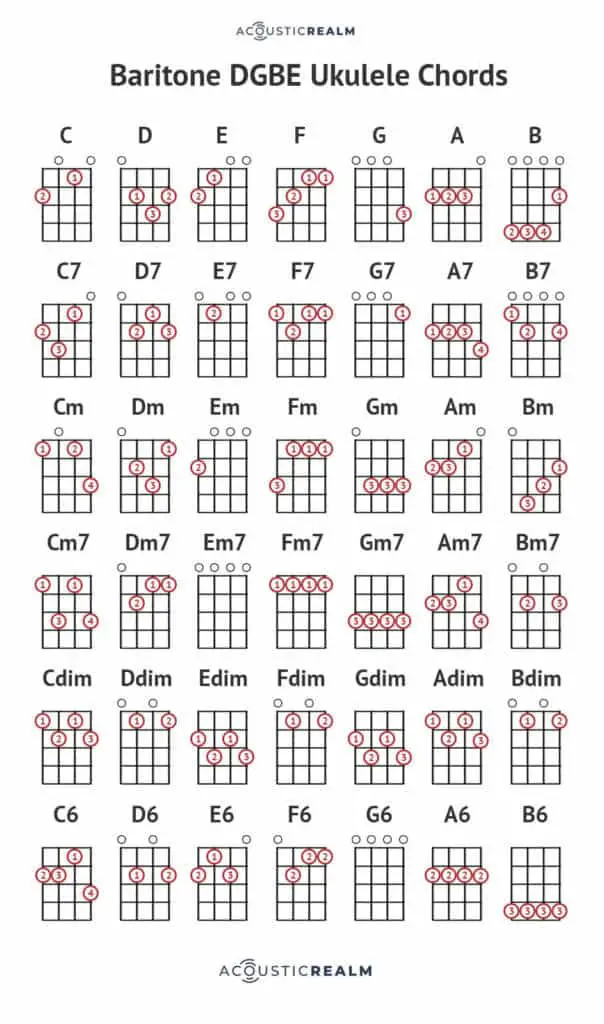
Of the four most popular ukulele sizes, the baritone uke is the odd one out.
It is tuned in a way that is similar to an acoustic guitar. This is not the standard tuning of the other sizes, but it does make for an easy transition for guitarists.
The bigger body means a deep and well-rounded tone with more bass frequencies shining through. The baritone uke is popular if you want a rich, deeper tone that is closer to classical guitar than soprano ukulele.
Of course, it all depends on what model of ukulele you buy, and how you set it up. More on this later.
Baritone strings are tuned DGBE, the same as the top four strings of the guitar. The other three mainstream sizes of uke, the soprano, concert, and tenor, are tuned GCEA. This is called “re-entrant” tuning.
You can use the standard tuning on these ukuleles, but only if you have a suitable string set like this one by Aquila. GCEA tuning will give you a more traditional uke tone.
Best Ways to Tune Your Baritone Uke
When it comes to baritone ukulele tuning you’ve got a few options. As well as deciding on the specific tuning you are going to use, you need to work out a method of tuning reliably.
Best (Physical) Tuner to Tune a Baritone Ukulele
Carrying a tuner in your gig bag is the best way to ensure you can always tune accurately.
The KLIQ UberTuner is a chromatic multi-instrument tuner that is a perfect companion for musicians playing guitar, banjo, ukulele, or just about any other string instrument.
Keep in mind the fact that it is actually easier to use the guitar tuning setting because of the DGBE tuning. The UberTuner will detect that you’re playing in a bari uke/guitar tuning and detect the correct pitch.
A cheaper alternative is the Donner Ukulele Guitar Tuner which has a simpler display but still allows you to tune any type of ukulele, regardless of whether you are using re-entrant tuning or not. Just like the UberTuner, it is easier to use the guitar tuner setting if you are using DGBE tuning to play your instrument.
This model only has a 6-month warranty, whereas the Ubertuner has 3 years. Both clip onto your instrument and should easily fit in your ukulele bag or case.
Ukulele Tuner Apps
Most of us carry our phones all the time, and there are loads of apps that can help ukulele players. Ukulele tuner apps are pretty reliable. They use the microphone in your smartphone to detect the pitch, and a visual interface to show you how to adjust and tune each string.
For an overview, of the best options, check out our full guide to ukulele tuning apps. Using an app tuner has a few advantages and disadvantages:
Pros:
- Some apps have lesson functions included (GuitarTuna).
- There are free apps on the market that you can use.
- Some apps include libraries of chord shapes and songs.
- There are numerous options for both iPhone and Android.
Cons:
- Many apps charge for alternate tunings.
- They’re hard to use in loud places, or if you don’t have a brilliant microphone on your phone.
- If you run out of phone battery, you can’t use your tuner.
Online by Ear
Tuning by ear is when you listen to a reference tone and tune your strings to the same pitch. Ukulele-Tabs.com has a free baritone setting for DGBE tuning. You can listen to the pitch each string should be and tweak the tuning pegs accordingly.
This is a useful skill to develop for musicians. Some people become so familiar with ukulele or guitar tuning that they don’t even need the reference tone to tune up. The problem is that if you don’t have the best sense of pitch, you will end up with an imperfect tuning.
You also need to make sure you always have an internet connection for this method. It’s useful if you’re stuck in a rut and don’t have your tuner, but I don’t recommend it as your standard ukulele tuning method.
Baritone DGBE Tuning Chords Chart
Before you start strumming away, you need to know some chords. The standard baritone tuning being closer to the tuning of a guitar means that the chord shapes are different from a soprano or concert ukulele.
The chart below will be scary if you’re not used to linear tuning. If you’re transitioning from playing guitar chords, you’ll notice a pattern…
The chord shapes are the same as the corresponding guitar versions, just with the lowest two strings of a guitar ignored. From the g string up to the high e string, the finger positions are the same as those you would play on your acoustic guitar.

Using a Ukulele Capo
A lot of uke players also use a capo to change the pitch of the strings. These devices clamp down on all four baritone ukulele strings and effectively move the location of the nut. This changes the default pitch of the instrument.
What’s the point in this?
Well, it’s a handy trick for uke players! A capo lets you use the same handshapes and chord shapes to play a song in a different key.
You can use this technique to make a song easier to play, which is always a bonus. If you find some chord shapes hard, you will be able to play the same chords higher up the neck by using a capo.
Other common uses include matching up to a vocalist’s range so that the ukulele songs you are enjoying are in key with the singing.
Putting a capo on the fourth fret has the impact of changing the pitch upwards by four half steps. The notes you now hear are four half steps higher up a scale. Playing a C chord hand shape will now give you an E chord.
“Shortening” the strings and the scale length also gives the tone a beautiful and bright shimmer. Your baritone ukulele will now sound more like a soprano or tenor ukulele.
The Planet Waves PW-CP-12 NS Ukulele Capo Pro is a reliable and accurate capo that works on any type of ukulele with four strings. If you’re a professional, it is worth paying extra for this model as it ensures no buzz using micrometer tension adjustment.
If you want something with a bit of character that sticks with a Hawaiian ukulele theme, the Shark Capo will raise a smile as well as raising the pitch.
6 String Baritone Ukulele Tuning
A lot of people confuse a 6-string baritone uke with a guitalele. Both have six strings and they are similar in size.
The guitalele tuning is ADGCEa (the small “a” means a high a). This makes it just like playing a guitar with a capo on the fifth fret. The ADGCEa intervals are the same as the standard tuning of a guitar, EADGBe.
A baritone ukulele with 6-strings is tuned GCCEAA. The two C strings are tuned one octave apart, and sometimes, the two A strings are tuned one octave apart too.
Notice that we are back to re-entrant tuning. The GCEA are just doubled up in two places, with two C strings and two A strings. The lower C string and the bigger body of the 6-sting bari uke give a lower tone than a tenor ukulele or another smaller uke.
If you are used to playing with re-entrant tuning, you can adjust by playing the chords just like you would with G-C-E-A tuning, but by holding the frets down in the same place on both the C and A strings. Some people find this adjustment easy, especially when playing chords that don’t require you to hold down both the A and C strings.
Conclusion
The deeper tone is what gives the baritone ukulele its unique appeal. As we’ve covered, you can choose among different options and how you want to tune your instrument. Many people make that decision based on whether they’re switching from a smaller concert ukulele or evolving from playing guitar chords.
You can use standard ukulele tuning or a tuning closer to the strings of a guitar. As long as you use the correct ukulele chords, your baritone uke can be a fun and beautiful accompaniment.
Anna teaches piano and guitar and also has extensive experience recording music. She’s well read in music psychology and love to share the benefits of learning to play music.
